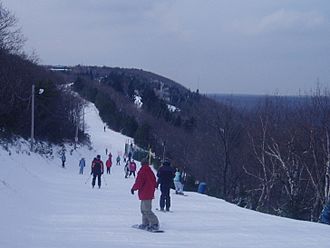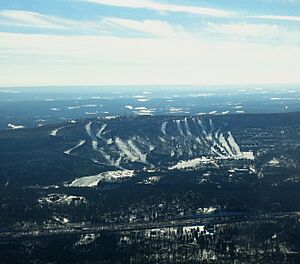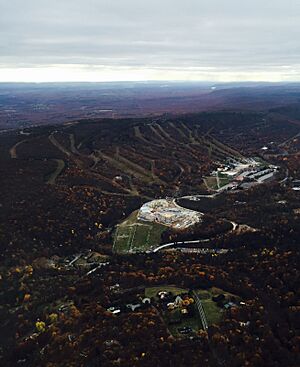Camelback Mountain Resort facts for kids
Quick facts for kids Camelback Ski Area |
|
|---|---|

On the "Little Caesar" trail
|
|
| Location | Pocono Township / Jackson Township, Monroe County, near Tannersville, Pennsylvania, USA |
| Nearest city | Scranton |
| Coordinates | 41°03′05″N 75°21′19″W / 41.05139°N 75.35528°W |
| Vertical | 800 feet (240 m) |
| Top elevation | 2,133 feet (650 m) |
| Skiable area | 166 acres (0.67 km2) |
| Runs | 35 trails |
| Longest run | "Nile Mile" – 4,646 feet (1,416 m) |
| Lift system | 16 2 high-speed detachable quad chairlifts, 3 triple chairlifts, 5 double chairlifts, 4 Surface lifts, 2 Tubing Surface Lifts |
| Terrain parks | 2 |
| Snowfall | 50 in/yr (1.27 m/yr) |
| Website | http://www.skicamelback.com |
Camelback Mountain Resort is a popular place in the Pocono Mountains of Pennsylvania. It's a fun spot for both skiing and snowboarding. Part of the resort is even next to a state park called Big Pocono State Park.
Back in the 1950s, when the resort was growing, its owners made a deal. They were allowed to use a small part of the state park. In return, they paid just $1 a year and agreed to help take care of the entire park.
The mountain itself is called Camelback Mountain (Big Pocono). It reaches a height of 2,133 feet (650 m). There are 166 acres (0.67 km2) of slopes for skiing and snowboarding. The mountain has 35 different trails. The longest trail is called "Nile Mile" and it's 1 mile (1,600 m) long! The mountain also has a vertical drop of 800 feet (240 m).
To get up the mountain, there are 15 lifts. Two of these are fast, high-speed chairlifts called the Sullivan Express and Stevenson Express. Camelback is the biggest ski resort in the Poconos. It also has two special areas for tricks and jumps, called terrain parks. The resort first opened in December 1963. On average, the top of the mountain gets about 50 inches (130 cm) of snow each winter. If there isn't enough natural snow, the resort can make its own snow. All the slopes are lit up, so you can even ski at night!
Camelback Mountain Resort is about 2 miles (3.2 km) from Pinemere Camp. It's also about 45 miles (72 km) north of Allentown, Pennsylvania. The resort has put a lot of effort into its ski and snowboard lessons. They even have a saying: "Learn Here, Learn Right."
Contents
Camelback Resort: Fun All Year Round
Camelback Mountain Resort is more than just a ski area. It also has a huge indoor waterpark and many other adventures!
Aquatopia Indoor Waterpark
The Camelback Resort and Indoor Waterpark opened in May 2015. Its waterpark is called Aquatopia. In 2015, USA Today voted it the #1 Indoor Waterpark in the country! The indoor park is open all year long. There is also an outdoor waterpark that is open only in the summer.
Aquatopia has over 37 waterslides. This is the most waterslides in all of Pennsylvania! It includes different kinds of slides like body slides, mat slides, and tube slides. There are also four raft rides. Besides slides, Aquatopia has a 30,000-square-foot (2,800 m2) wave pool and a lazy river. There's a special play area just for kids. You can even try surfing or boogie boarding on the FlowRider wave pool!
Camelback Mountain Adventures
Camelback Mountain Adventures offers many exciting activities. You can try Treetop Adventure courses, which are like obstacle courses high up in the trees. There's a 1,000 ft (300 m) zipline and an even longer 4,000 ft (1,200 m) ZipFlyer. You can also ride Mountain Segways or play Disc Golf. A fun 4,500 feet (1,400 m) Mountain Coaster lets you zoom down the mountain.
The Adventure Zone has more activities like a Climbing Wall, EuroBungee, and a Freefall Airbag Jump. Soon, an Alpine Slide will also be added. Camelback Mountain Adventures is open from June to November.
Exploring the Ski Trails
Camelback Mountain has many different ski trails for all skill levels. Here are some of them:
- The Birches
 (Beginner)
(Beginner) - King Tut
 (Intermediate)
(Intermediate) - The Hump
 (Expert)
(Expert) - The Asp
 (Expert)
(Expert) - The Rocket
 (Expert)
(Expert) - Marje's Delight
 (Expert)
(Expert) - The Dromedary
 (Beginner)
(Beginner) - Big Pocono Run
 (Intermediate)
(Intermediate) - Upper Cleopatra
 (Intermediate)
(Intermediate) - Marc Anthony
 (Beginner)
(Beginner) - Julius Caesar
 (Beginner)
(Beginner) - Little Caesar
 (Beginner)
(Beginner) - Laurel Glade
 (Beginner)
(Beginner) - Coolmoor
 (Beginner)
(Beginner) - The Meadows
 (Beginner)
(Beginner) - John Bailey
 (Expert)
(Expert) - Sulivan's Trail
 (Expert)
(Expert) - The Sphinx
 (Beginner)
(Beginner) - Honeymoon Lane
 (Beginner)
(Beginner) - Home Again
 (Beginner)
(Beginner) - Lower Cleopatra
 (Intermediate)
(Intermediate) - Sunbowl
 (Beginner)
(Beginner) - Oak Grove
 (Beginner)
(Beginner) - Turkey Trot
 (Beginner)
(Beginner) - Upper Moore's Ramble
 (Beginner)
(Beginner) - Lower Moore's Ramble
 (Beginner)
(Beginner) - Pocono Raceway
 (Intermediate)
(Intermediate) - The Pharaoh
 (Expert)
(Expert) - The Bactrian
 (Intermediate)
(Intermediate) - Cliffhanger
 (Expert)
(Expert) - Near East
 (Intermediate)
(Intermediate) - The Nile Mile
 (Intermediate)
(Intermediate) - Basilisk
 (Expert)
(Expert)



